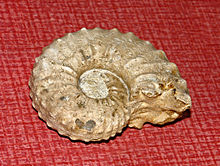Kamerunoceras is an extinct cephalopod genus belonging to the ammonite family Acanthoceratidae, found in Upper Cretaceous formations of Africa, Europe and North and South America.

Coilopoceratidae is a family of generally large, proper ammonites with strongly involute shells from the Cretaceous, Albian to Turonian. Coilopoceratids have variably compressed shells with flattish to broadly rounded sides and narrowly rounded to sharp keel-like venters. Whorl sections are generally lanceolate. The suture is ammonitic with an overall clumpy appearance.

Parahoplitidae is an extinct family of Cretaceous ammonites with stoutly ribbed, compressed, generally involute shells lacking or with only minor tubercles included in the Deshayestoidea, a superfamily now separated from the Hoplitacaceae.

Acanthoceratidae is an extinct family of acanthoceratoid cephalopods in the order Ammonitida, known from the Upper Cretaceous. The type genus is Acanthoceras.

Exiteloceras is an ammonite genus from the Late Cretaceous.
Ancyloceratoidea, formerly Ancylocerataceae, is a superfamily of typically uncoiled and loosely coiled heteromorph ammonoids established by Alpheus Hyatt in 1900, that may contain as many as 11 families, depending on the classification accepted.

Collignoniceratidae is a family of Upper Cretaceous ammonites characterized by typically more or less evolute shells with compressed, oval, or square whorl sections; serrate or entire keels; and dense ribs with one to 5 tubercles.

Mammites is a Late Cretaceous ammonite genus included in the acanthoceratoidean family, Acanthoceratidae, and the type genus for the subfamily Mammitinae. Mammites was named by Laube and Bruder in 1887.

Lytoceratidae is a taxonomic family of ammonoid cephalopods belonging to the suborder Lytoceratina, characterized by very evolute shells that generally enlarge rapidly, having whorls in contact but mostly overlapping very sightly, or not at all.

Mantelliceras is an extinct ammonoid cephalopod genus belonging to the family Acanthoceratidae and type for the subfamily Mantelliceratinae, that lived from the Late Albian to the late Cenomanian stage of the Late Cretaceous.

Neocomitidae is a family of Lower Cretaceous ammonitids comprising genera with strongly ribbed evolute to smooth, fairly involute shells.

The family Dactylioceratidae comprises Early Jurassic ammonite genera with ribbed and commonly tuberculate shells that resembled later Middle Jurassic stephanoceratids and Upper Jurassic perisphinctids. Shells may be either evolute or involute.

Watinoceras is a genus of acanthoceratid ammonite that lived during the early Turonian stage of the Late Cretaceous.

Mammitinae comprises a subfamily within the Acanthoceratidae (Ammonoidea) characterized by moderately to very evolute shells with rectangular to squarish whorl sections along with blunt umbilical and prominent inner and outer ventrolateral tubercles on sparse ribs that may be round and strong, sharp and narrow, or absent. The suture is somewhat simpler than that of the Acanthoceratinae. Range is restricted to the lower Turonian stage of the Upper Cretaceous.
Cunningtoniceras is a stocky acanthoceratid ammonite from the upper Cenomanian stage of the late Cretaceous of the western U.S., found e.g. in Arizona and New Mexico.
Neocardioceras is a genus of evolute acanthoceratid ammonites from the uppermost Cenomanian, Upper Cretaceous, of Europe, western U.S. and Brazil.
Euomphaloceratinae is a subfamily of Upper Cretaceous ammonites included in the Acanthoceratidae, characterized by generally evolute shells with quadrate whorl sections that are strongly ribbed. Sutures are ammonitic, but not overly complex.
Euomphaloceras is an early Upper Cretaceous ammonite genus,, included in the Acanthoceratinae until established as the type genus for the Euomphaloceratinae by Cooper, 1978.
Romaniceras is a genus of Upper Cretaceous ammonites in the Acanthoceratidae subfamily Euomphaloceratinae.
Binneyitidae is a family of Upper Cretaceous ammonoid cephalopods characterized by rather small, compressed, flat sided shells and sutures that tend to have deep, narrow, simple elements with parallel sides, that range from the upper Cenomanian into the lower Santonian.










